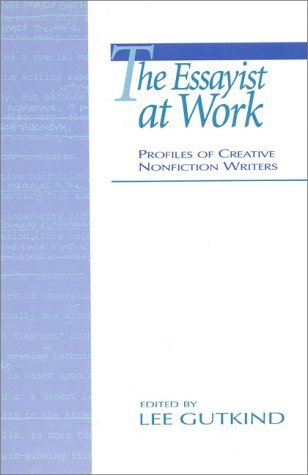

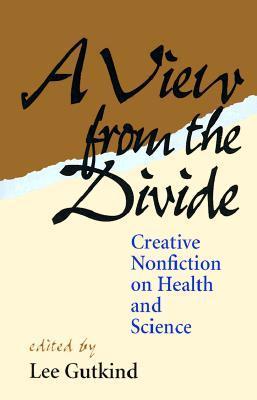
Creative Nonfiction
Series · 22
books · 1993-2025
Books in series
#1
Creative Nonfiction No. 1
1993

#6
The Essayist at Work
Profiles of Creative Nonfiction Writers
1998
Today, creative nonfiction/literary journalism encompasses the length and breadth of the literary spectrum. The Essayist at Work offers proven methods for making a mark in this competitive genre.

#9
The Universal Chord
1998

#11
A View From The Divide
Creative Nonfiction on Health and Science
1998
In the tradition of Lewis Thomas, Stephen J. Gould, and Oliver Sachs, this special double issue of Creative Nonfiction, the only exclusively nonfiction literary journal, demonstrates the many ways in which aspects of the scientific world—from biology, medicine, physics, and astronomy—can be captured and dramatized for a humanities-oriented readership. Edited and introduced by the award-winning author of Many Sleepless Nights, An Unspoken Art, and A View from the Divide includes a diverse range of voices, from poets to immunologists and physicists, from established writers to up-and-coming new talent.
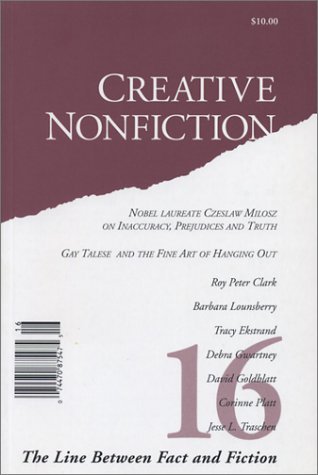
#16
The Line Between Fact and Fiction
2000
Featuring Nobel Laureate Czeslaw Milosz, a profile of Gay Talese, and journalist Roy Peter Clark
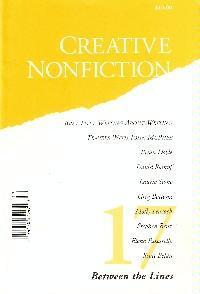
#17
Between the Lines
2001
This issue features essays that, among other things, take us between the lines—writers writing about writing—in a variety of creative and informative contexts. Novelist Bret Lott speaks out "Against Technique," while Canadian journalist David Hayes analyzes the "inner monologue" ("Penetrating Thoughts"), an often-debated creative nonfiction technique and tool. The Hayes essay, along with Michael Rosenwald's report of his recent encounter with Pulitzer Prize-winning New Yorker writer John McPhee ("Travels with John McPhee"), are located in the back of the issue in a section of the same name, "Between the Lines."
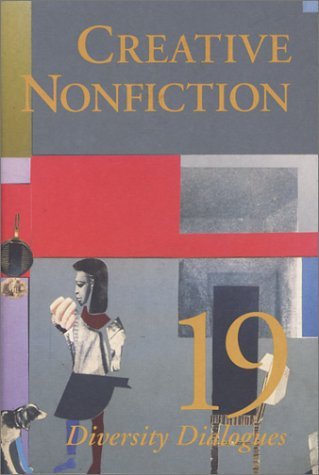
#19
Diversity Dialogues
2002
In "Diversity Dialogues," Issue 19 of Creative Nonfiction, celebrated authors like John Edgar Wideman, Francine Prose, Andrei Codescru, Terry Tempest Williams and Richard Rodriguez write essays about diversity that defy easy labels. To seek out new voices, Creative Nonfiction teamed up with JPMorganChase to offer a $10,000 prize for narratives about the challenges faced by outsiders in a world where "normal," "regular" and "accepted" are the watchwords and all others are marginalized. The collection includes an essay by Floyd Skloot, who, having suffered from a virus that attacked and damaged his brain 12 years ago, ponders his disabled status. Skloot is the recipient of the $10,000 Walter V. Shipley Award, named for the retired chairman of the Chase board. Long noted for its diversity initiatives and cited as a model for other financial institutions, Chase began concentrating on diversity issues under the guidance of Shipley, who sought to create a work environment that embraced a mix of race, cultures, ages, religions, and orientations.

#21
Rage & Reconciliation
Inspiring a Health Care Revolution
2003
Book by
#23
Creative Nonfiction #23
2004
Text in English
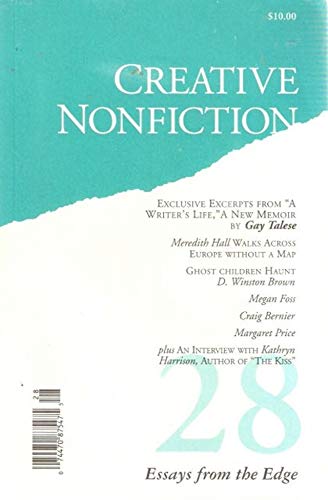
#28
Creative Nonfiction 28 Essays From the Edge
2005
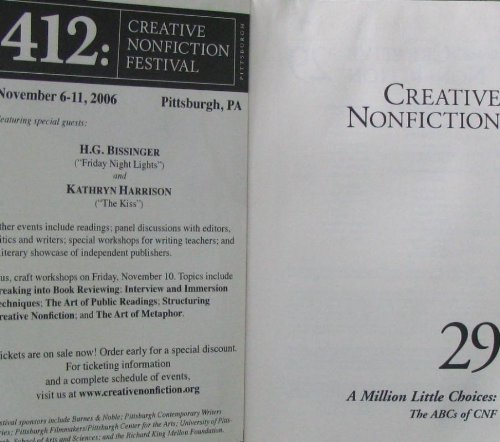
#29
A Million Little Choices
The ABCs Of CNF
2006
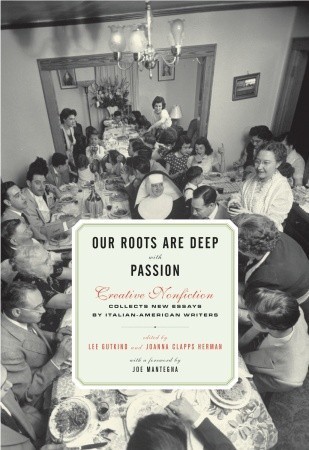
#30
Our Roots Are Deep with Passion
New Essays by Italian-American Writers
2006
Thoughtful, poignant, and hilarious personal essays collected by the editors of Creative Nonfiction explore the meanings of Italian-American identity.
In the twenty-one nonfiction narratives collected in Our Roots Are Deep with Passion, established and emerging writers with family ties to Italy reflect on the ways that their lives have been accented with uniquely Italian-American flavors. Several of the essays breathe new life into the time-honored theme of family—Louise DeSalvo honors her grandfather, nick-named “the drunk” because he spent his life of hard work drinking wine instead of water, and James Vescovi portrays the close of the stormy relationship between his father and grandmother. Other stories tackle the mystical side of Italian-American life, like Laura Valeri’s account of a summer vacation séance in Sardinia that goes eerily awry. And elsewhere, Stephanie Susnjara charts the history of garlic in society and her kitchen, and Gina Barreca offers an unabashed confession of congenital jealousy.
Lee Gutkind, founding editor of Creative Nonfiction, the nation’s premier nonfiction prose literary journal, and Joanna Clapps Herman have brought together artful essays by novelists, scholars, critics, and memoirists from across the country. The pieces are as varied as their authors, but all explore the unique intersections of language, tradition, cuisine, and culture that characterize the diverse experience of Americans of Italian heritage.
#32
Creative Nonfiction
2025
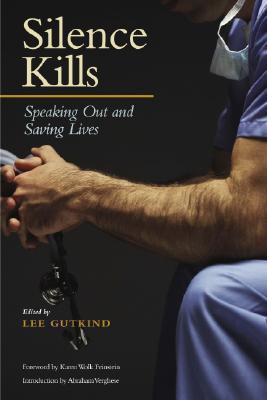
#33
Silence Kills
Speaking Out and Saving Lives
2007
Written by physicians, caregivers, patients, and family members, the twelve essays collected in Silence Kills present a compelling, and often frightening, insider look at the lack of communication and understanding currently plaguing the American health care system.These stories explore a wide and complicated range of experiences—a doctor is pressured into sending a patient home from the emergency room but later must face his decision when the patient suddenly dies; a physician must deal with her self-doubt as she faces a malpractice lawsuit and must come to terms with the fact that even doctors are fallible and human; a woman fights for her mother's mental health and well-being against a system eager to over-medicate the elderly; and more—but all share one thing: a frustration with a system that hinders communication and often leads to unnecessary suffering.
Inspired by groundbreaking research by VitalSmarts, a global leader in organizational performance and leadership, and the American Association of Critical-Care Nurses (AACN), and supported by the Jewish Healthcare Foundation, Lee Gutkind, editor and founder of Creative Nonfiction, has collected the essays in this volume—in the hope that these voices, speaking out, taking action and risks, will inspire others to make changes that will improve communication within our troubled health care system.
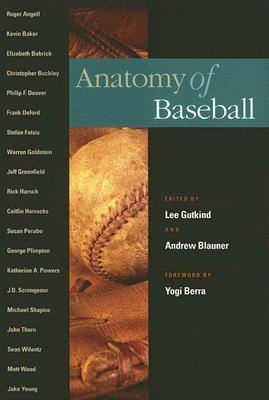
#34
Anatomy Of Baseball
2008
20 Writers Play Ball in 17 New Essays and 3 Classics. Stefan Fatsis sends his ?stunningly perfect, consummately perfect, why-would-anyone-use-anything-else? perfect” glove to be restored by the Glove Designer at Rawlings; Susan Perabo considers retiring from her imaginary career in the majors and assesses the likelihood of women finding actual careers on the baseball field; Sean Wilentz imagines a Cooperstown Fans’ Hall of Fame, with its cowbells, frying pans, bedsheet banners, and more. And in one of the three previously published, now-classic pieces in the collection, George Plimpton reflects on the slow demotion of aging or slumping players from pitcher to first base, to the outfield. United by the authors’ fervent love of the game, these essays remind us of the unique role baseball plays in our national history and collective imagination.
#40
Creative Nonfiction Issue 40
2011
#41
Creative Nonfiction Issue 41
2011
True stories, well told. Food issue.

#43
Creative Nonfiction Issue 43
2012
Creative Nonfiction Anger & Revenge Issue

#47
Creative Nonfiction Issue 47
2013
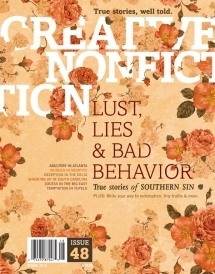
#48
Creative Nonfiction Issue 48
2013
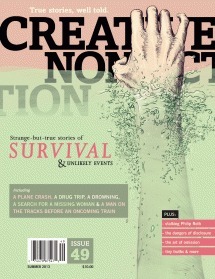
#49
Creative Nonfiction Issue 49
2013
Our summer issue is devoted to hair-raising stories of near misses. Writers reflect on narrow escapes from a plane crash, youthful recklessness, and a train barreling down on the station.
The rest of the issue is a writer's survival guide, with notes on making dialogue work, a love letter to literary letters, Roxane Gay on the dangers of disclosure, and a visual guide to the personal essay. Plus, we're stalking Philip Roth.

#2425
In Fact
The Best of Creative Nonfiction
2004
Creative nonfiction, also known as narrative nonfiction, liberated journalism by inviting writers to dramatize, interpret, speculate, and even re-create their subjects. Lee Gutkind collects twenty-five essays that flourished in this new turf, all originally published in the groundbreaking journal he founded, Creative Nonfiction, now in its tenth anniversary year.
Many of the writers here are crossing genres—from poetry to fiction to nonfiction. Annie Dillard provides the introduction, while Gutkind discusses the creative and ethical parameters of this new genre. The selections themselves are broad and fascinating. Lauren Slater is a therapist in the institution where she was once a patient. John Edgar Wideman reacts passionately to the unjust murder of Emmett Till. Charles Simic contemplates raucous gatherings at his Uncle Boris' apartment, while John McPhee creates a rare, personal, album quilt of his own life. Terry Tempest Williams speaks on the decline of the prairie dog, and Madison Smartt Bell invades Haiti.
Authors
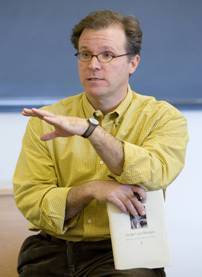
Ilan Stavans
Author · 31 books
Ilan Stavans is the Lewis-Sebring Professor in Latin American and Latino Culture at Amherst College. An award-winning writer and public television host, his books include Growing Up Latino and Spanglish. A native of Mexico City, he lives in Amherst, Massachusetts.
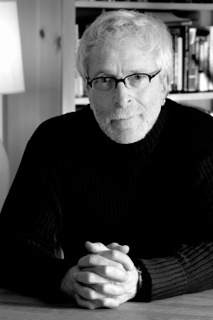
Lee Gutkind
Author · 35 books
Lee Gutkind has been recognized by Vanity Fair as “the godfather behind creative nonfiction.” A prolific writer, he has authored and edited over twenty-five books, and is the founder and editor of Creative Nonfiction, the first and largest literary magazine to publish only narrative nonfiction. Gutkind has received grants, honors, and awards from numerous organizations including the National Endowment for the Arts and the National Science Foundation. A man of many talents, Gutkind has been a motorcyclist, medical insider, sports expert, sailor, and college professor. He is currently distinguished writer in residence in the Consortium for Science, Policy, and Outcomes at Arizona State University and a professor in the Hugh Downs School of Human Communication.